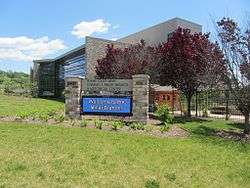Gray Rock (Ellicott City, Maryland)
| Gray Rock | |
|---|---|
|
Charles E. Miller Library on section of Gray Rock Property | |
| General information | |
| Type | House |
| Location | Ellicott City, Maryland |
| Coordinates | 39°16′2″N 76°51′26″W / 39.26722°N 76.85722°WCoordinates: 39°16′2″N 76°51′26″W / 39.26722°N 76.85722°W |
| Construction started | 1813 |
Gray Rock is a historic slave plantation home located in Ellicott City, Maryland.[1][2]
History
Gray Rock (also called Grey Rock) is situated next to Font Hill Manor, a plantation house built in the 1700s by Admiral Hammond. Caleb Dorsey of Belmont had three sons. Thomas Beale Dorsey, became the Attorney General of Maryland, and later built the farm at age 55 in order to be closer to his other two brothers. The farm was assembled in 1813 from many tracts of land including, Pinkstone's Delight, Fifth Edition, Ben's luck, Rebbecca's Lot, Gaither's Adventure-Ferry Bridge. In 1816 Freeborns Progress-Smith's Fortune and Addition to Freeborns Progress were added. In 1817, Ben's Delight, John's Luck, The Triangle, and Kelly's Neglect were assembled.
The home is a four by one bay wooden structure standing two and a half stories tall based on a clapboard covered log home that predates the 1813 purchases. An additional one and a half story stone house is on the property that served as slave quarters for two families. The property also included several large wooden barns and a carriage house. The farm was situated along the Baltimore-Frederick turnpike road.[3] It is now surrounded by a residential cul-de-sac at 3518 Angus Valley Trail.[4]
Thomas Beale Dorsey of Thomas died at Gray Rock on 6 September 1828 at the age of 60.[5] The property passed to his daughter Sarah and her husband Dr. Arthur Pue in 1837 after the death of her mother Achsah Dorsey. (Pue was the family doctor to Peter Gorman and their son, Senator Arthur Pue Gorman). On 7 May 1848 the farm was inherited by their son Thomas Beale Dorsey Pue. In 1859, his father sold the 404 acre farm to James Mackubin for $32,000. In 1879, John H Herbert claimed a crop of 523 and 1000 bushels of Fultz wheat from two of Gray Rock's fields.[6] In 1867, 43 acres were split off to Mackubbin where the MacApline Manor was built. The property was sold and leased back to MacKubbin until his death in 1904 when it was sold to the Sloatfield family finalized in 1911.
On 14 May 1943, former Howard County Commissioner Charles E. Miller purchased the farm. Miller attempted multiple time to subdivide the farm for residential development. His company Miller Land Company submitted plans in 1978. In a 1981 historical survey, two headstones of the Pue family were documented, and several were found to be knocked over and covered with concrete pavement. The property was subdivided into a 331 and 22 acre Miller Land Company plots, a 50-acre section dedicated to the Lutheran Hospital of Maryland, and several small plots occupied by the library. In 1992, citizens were concerned the current county executive Charles I. Ecker was fast tracking the process.[7] 1996, Gray Rock Drive went from access road to the farm to a through street.[8]
See also
References
- ↑ "HO-412 Gray Rock" (PDF). Retrieved 17 November 2013.
- ↑ Seeking Freedom The History of the Underground Railroad in Howard County. p. 68.
- ↑ "HO-412 Gray Rock" (PDF). Retrieved 17 November 2013.
- ↑ Missy Burke; Robin Emrich; Barbara Kellner. Oh, You must live in Columbia. p. 23.
- ↑ Helen West Ridgely. Historic Graves of Maryland and the District of Columbia. p. 154.
- ↑ "Howard County Affairs". The Baltimore Sun. 3 September 1879.
- ↑ Erik Nelson (4 December 1992). "Battle over road between Gray Rock Farm and Dorsey Hall nears its end". Baltimore Sun.
- ↑ Missy Burke; Robin Emrich; Barbara Kellner. Oh, You must live in Columbia. p. 23.
